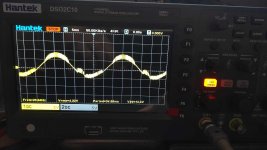No. Without the muting transistor (haven't fitted new one yet) Channel A works just fine, and the Channel B the waveform is in post #13.
Same. Almost Indistinguishable either if it's a 4 ohm driver or 4 ohm resistor. Both have the same distortion and both put the amp in protect mode above around 5vrms if played for more than a 2-3 seconds.
Other channel is fine on both dummy load and driver.
Other channel is fine on both dummy load and driver.
Is the noise present on pin 4 or 8 of the op-amp in that area?
Do you see the noise on the source terminals or gates of any of the output transistors in that channel?
Do you see the noise on the source terminals or gates of any of the output transistors in that channel?
Is the noise present on pin 4 or 8 of the op-amp in that area? - i cannot see almost anything on those pins. Almost looks like a pure DC.
Do you see the noise on the source terminals or gates of any of the output transistors in that channel? - Present. I checked the gate referenced to source.
What I've noticed while checking it's if You put a load at Channel B, the faulty one, it introduces the same distortion in channel A. But if You only play channel A there is no issue.
This is what I get on the working channel A, whenever I put any load on Channel B. Playing only channel A without anything in channel B, is perfectly fine. And of course it goes into protect soon after. So why or how would channel B affect channel A ? They only share the PS section and the auxilary voltages ?
Do you see the noise on the source terminals or gates of any of the output transistors in that channel? - Present. I checked the gate referenced to source.
What I've noticed while checking it's if You put a load at Channel B, the faulty one, it introduces the same distortion in channel A. But if You only play channel A there is no issue.
This is what I get on the working channel A, whenever I put any load on Channel B. Playing only channel A without anything in channel B, is perfectly fine. And of course it goes into protect soon after. So why or how would channel B affect channel A ? They only share the PS section and the auxilary voltages ?
Attachments
When the noise is on both channels, is the noise present anywhere else (primary? Secondary on preamp components (before the points where you jumped the channels)?
At this point, is this noise audible?
What type of scope probes are you using, standard type or the type like on a multimeter?
What type of scope probes are you using, standard type or the type like on a multimeter?
At this point, is this noise audible? = yes, it can be clearly heard even with subwoofer with the LPF filter on, once the output level surpasses 4-5vrms.
What type of scope probes are you using = standart bnc ones, I thought the issue may be with my scope, but even my handheld one with an integrated battery, shows the same distortion (just in a lower resolution).
What type of scope probes are you using = standart bnc ones, I thought the issue may be with my scope, but even my handheld one with an integrated battery, shows the same distortion (just in a lower resolution).
Yes. Same behaviour.I might return the amplifier to it's owner with only 1 channel working. At some point it's not worth investing any more time.
I've fitted a new BC850 from a donor board at Q9. But once it is in place the bias adjustment stopped working anymore as it was before and the distortion is back for both channels. I think there is something from the "bad" channel that provokes/induces this as the mute transistor is a common point for the both channels.
Does installing a shunt on the bias defeat header in the bad channel change anything with the good channel bias?
If you remove the two 56 ohm resistors driving the bias supply transistors on the bad channel, does that allow the good channel to bias?
If you remove the two 56 ohm resistors driving the bias supply transistors on the bad channel, does that allow the good channel to bias?
- Home
- General Interest
- Car Audio
- Audio System X-Ion 280.2 bias issue?
